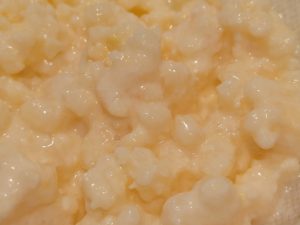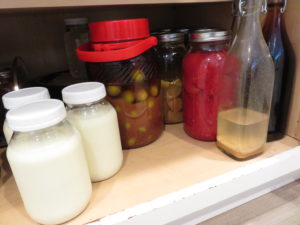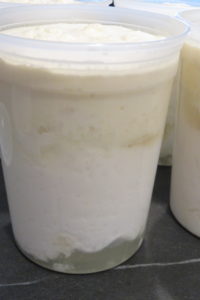
To make milk kefir at home you need milk kefir grains. You can buy them from an online store nowadays or ask your friends. Healthy grains are plump just like those in this photo.
Ingredients: 2 Tbs of milk kefir grain for 1 quart of milk to make 1 quart minus 2Tbs of Kefir. You also need some milk for storing the kefir grain while not brewing.
Ideally, the milk is raw milk from a Pasture-Raised cow. If you cannot buy raw milk, organic whole milk without any additive is Ok. Please make sure that it is not UHT or HTST Pasteurized.

Tools you need,
- Strainer
- Spatula
- Bowl
- Storage containers with lids
Kefir does not like any metal. So, all the tools must be either made of plastic or glass.
Instruction:
- Put milk and the grains into a container. Then mix them lightly with a spatula.
- Depending on your kitchen situation, you may need to cover the top with cheesecloth or paper towels and securing with a rubber band to prevent anything (dust, insects, etc.) to go in. Since I have a dedicated area for fermentation in my kitchen and do not need to worry about any intruders, I just put a lid very lightly on the top. Kefirs need to breathe. So, do not close the lid. And if you use a paper towel, make some holes with a toothpick.
- Leave it in a dark and calm place in your kitchen for 1 to 3 days (For GAPS Diet, it must be brewed more than 24 hours.) depending on the season or room temperature, and also your preference of taste. Longer the more being brewed, the kefir becomes thicker, sour, and tangy. If you brew too long, it becomes bitter.
- The temperature requirement varies. Depending on the information online, I found that it is range from 65 to 115 °F. In my house, depending on the season the room temperature goes from 62 to 80°F. I started to make Kefir when I learned about the GAPS diet for the first time which was in the summer of 2011. Till today, I never had any problem. Kefir making is much easier than yogurt making.
 This is my fermentation room under the kitchen counter. Once the door is closed, it is dark, cool, and calm. Any life is a manifestation of environmental energy. So, when I culture a life, I like to create a calm and peaceful space for them. I believe that environmental energy transfers to anything living in, especially at birth.
This is my fermentation room under the kitchen counter. Once the door is closed, it is dark, cool, and calm. Any life is a manifestation of environmental energy. So, when I culture a life, I like to create a calm and peaceful space for them. I believe that environmental energy transfers to anything living in, especially at birth.
Fermentation is a way of birthing life. So, we should pay attention with extra care.
5. After the Kefir is brewed the way you like; you need to strain and separate the kefir from grains using a strainer, spatula, and bowl. Please make sure not to squash the grains!

Store the white thick liquid in the storage container in the refrigerator. It should be good for the next two weeks for sure. Depending on the condition of storage, it may be fine for the third week. Over time, a White part may raise to the top and remain clear liquid which is the kefir whey that stays in the bottom. When you use the kefir, shake well or you can separate the whey and use it for another purpose such as fermenting vegetables.
 (This is a normal healthy kefir.)
(This is a normal healthy kefir.)
I know some of the instructions teach that you should make kefir every day. Yes! Ideally, It is right. But….so, let’s say that you are going on a vacation or business trip, you want to keep your kefir grain alive and healthy. Then store them in the refrigerator in a container of milk. Please make sure that the grains are happily covered and swimming in enough milk. I use only raw milk. Raw milk has a strong immunity against bad bacteria which spoil the milk or kefir. Please remember that where HEALTHY good bacteria grow, bad bacteria cannot grow. This is THE LAW of NATURE!
Just in case, if you doubt that kefir got bad, then you may need to throw them away. I never had an experience of my kefir going bad. Maybe because I always use raw milk. Here again, raw milk is the HEALTHIEST milk because of the nature ( immunity ) is living! So, if you use man-treated milk, the kefir may go bad easily. So, you need to pay more attention. Checked several online information, and my understanding is that when kefir goes bad, similar things with when homemade yogurt goes bad. There are some red, pink, yellow, or black spots showing up on the surface of the kefir. And also the texture become looked like it when you drop lemon juice into milk, or curdled milk.
The grains are living things, so they must be fed PROPER food for their integrity. Also, you must feed them often enough for them to survive. I make Kefir every other week. It means that I feed them fresh milk every two weeks. From my experience, Past three weeks of not being fed the grains may begin showing low energy and unhealthy. But they are still living! So feed them with a lot of fresh and high-quality milk in a bigger container which they can swim freely and happily. Most likely, they revive.




